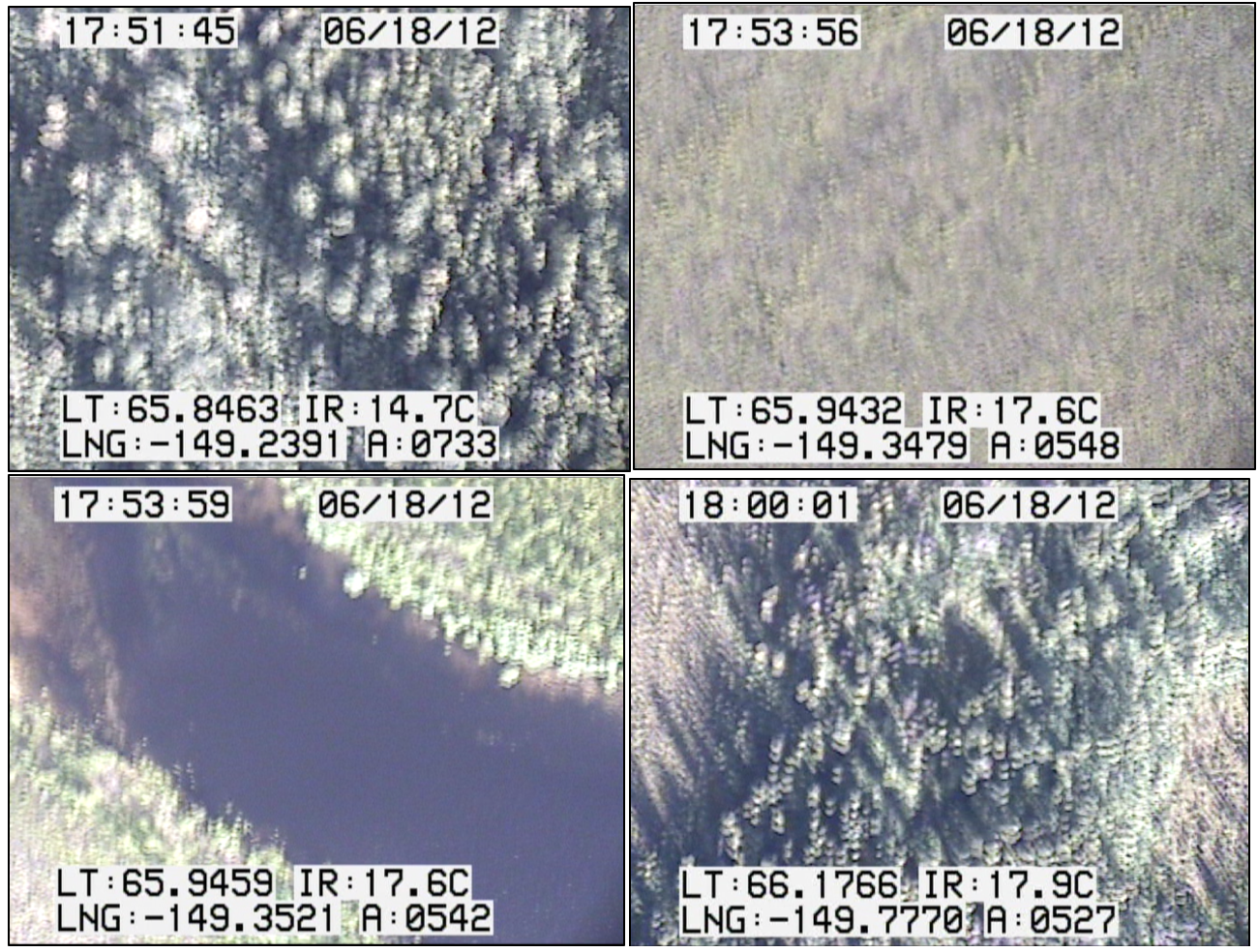Documentation Revision Date: 2017-09-20
Data Set Version: 1
Summary
This dataset contains 1470 videos in *.dv format.

Figure 1: Four still images from the flight on June 18, 2012. Videos show the Alaskan landscape conditions with open water and green vegetation (from video segment CARVE-Video-20120618180340-dv01_03.dv).
Citation
CARVE Science Team . 2017. CARVE: In-flight Videos from the CARVE Aircraft, Alaska, 2012-2015. ORNL DAAC, Oak Ridge, Tennessee, USA. https://doi.org/10.3334/ORNLDAAC/1433
Table of Contents
- Data Set Overview
- Data Characteristics
- Application and Derivation
- Quality Assessment
- Data Acquisition, Materials, and Methods
- Data Access
- References
Data Set Overview
Project: Carbon in Arctic Reservoirs Vulnerability Experiment
The Carbon in Arctic Reservoirs Vulnerability Experiment (CARVE) is a NASA Earth Ventures (EV-1) investigation designed to quantify correlations between atmospheric and surface state variables for Alaskan terrestrial ecosystems through intensive seasonal aircraft campaigns, ground-based observations, and analysis sustained over a 5-year mission. CARVE collected detailed measurements of greenhouse gases on local to regional scales in the Alaskan Arctic and demonstrated new remote sensing and improved modeling capabilities to quantify Arctic carbon fluxes and carbon cycle-climate processes. CARVE science fills a critical gap in Earth science knowledge and satisfies high priority objectives across NASA’s Carbon Cycle and Ecosystems, Atmospheric Composition, and Climate Variability & Change focus areas as well as the Air Quality and Ecosystems elements of the Applied Sciences program. CARVE data also complements and enhances the science return from current NASA and non-NASA sensors.
Related Data:
A full list of CARVE data products is available at: https://carve.ornl.gov/dataproducts.html
Data Characteristics
Spatial Coverage: CARVE flights over the Alaskan and Canadian Arctic
Spatial Resolution: Point measurements
Temporal Coverage: Periodic flights occurred during 2012 - 2015. Videos are not available from all flights.
Temporal Resolution: Videos were taken opportunistically during flights.
Study Area (coordinates in decimal degrees)
|
Site |
Westernmost Longitude |
Easternmost Longitude |
Northernmost Latitude |
Southernmost Latitude |
|
Alaska and Canadian Arctic |
-168.11 |
-131.75 |
71.56 |
58.84 |
Data File Information
This dataset contains 1470 videos in *.dv format. Each video segment is about 10 minutes in length. Each video frame is marked with the date and time as well as the latitude and longitude and the aircraft altitude.
File naming convention: Video files are named with the date and time of the beginning of the video segment, as:
CARVE-Video-YYYYMMDDHHMMSS-dvNN_NN.dv
where YYMMDD = the flight date and HHMMSS = the beginning time of the video segment. NN_NN are numerals that indicate the ordering of the videos within a flight. There are 30 - 50 video segments provided per flight. All dates and times are reported in UTC time.
Example file names: CARVE-Video-20120619230414-dv02_05.dv and CARVE-Video-20120619202428-dv01_17.dv
Application and Derivation
The CARVE project was designed to collect detailed measurements of important greenhouse gases on local to regional scales in the Alaskan Arctic and demonstrate new remote sensing and improved modeling capabilities to quantify Arctic carbon fluxes and carbon cycle-climate processes. The CARVE data provide insights into Arctic carbon cycling that may be useful in numerous applications.
Quality Assessment
Not applicable.
Data Acquisition, Materials, and Methods
CARVE Flights
These data represent one part of the data collected by the Carbon in Arctic Reservoirs Vulnerability Experiment (Miller et al. 2012). A C-23 Sherpa aircraft made frequent flights out of Fairbanks, Alaska between March and November over multiple years, observing the spring thaw, summer draw-down, and fall refreeze of the Arctic growing season. Flights concentrate observations on three study domains: the North Slope, the interior, and the Yukon River valley. North Slope flights cover regions of tundra and continuous permafrost and were anchored by flux towers in Barrow, Atqasuk, and Ivotuk. Flights to Prudhoe Bay characterize the CO2 and CH4 emissions from oil and natural gas processing plants. Flights over interior Alaska sample discontinuous permafrost, boreal forests, and wetlands. A complete list of CARVE flights can be found at: https://carve.ornl.gov/flights.html. Flight paths and atmospheric gas concentrations for CARVE surveys can be visualized through the CARVE Flight Data Visualization Tool (http://carve.ornl.gov/visualize).
The CARVE aircraft carried a remote sensing and atmospheric sampling payload consisting of the following instruments: a Fourier transform spectrometer (FTS), and an in situ gas analyzer suite (ISGA) with a gas analyzer and flask sampling system (see https://carve.ornl.gov/documentation.html). All instruments were controlled by a master computer system and UTC time stamped at 1 second intervals.
Videos were captured from a camera mounted on the aircraft during the CARVE flights to document the landscape and conditions encountered during each flight.
Data Access
These data are available through the Oak Ridge National Laboratory (ORNL) Distributed Active Archive Center (DAAC).
CARVE: In-flight Videos from the CARVE Aircraft, Alaska, 2012-2015
Contact for Data Center Access Information:
- E-mail: uso@daac.ornl.gov
- Telephone: +1 (865) 241-3952
References
Miller, C.E., Dinardo, S.J. et al. (2012). CARVE: The Carbon in Arctic Reservoirs Vulnerability Experiment., 2012 IEEE Aerospace Conference. http://dx.doi.org/10.1109/AERO.2012.6187026